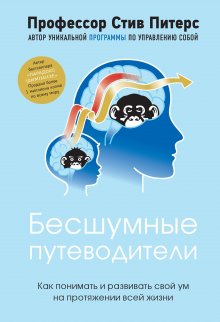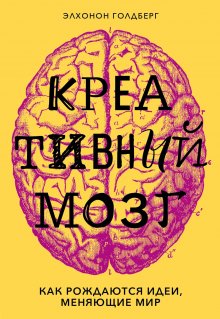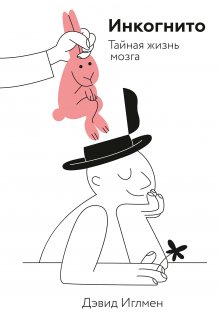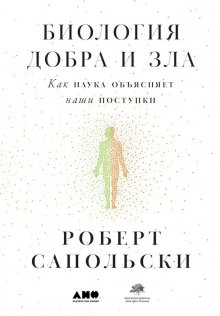Стив Питерс - Бесшумные путеводители. Как понимать и развивать свой ум на протяжении всей жизни

Все авторские права соблюдены. Напишите нам, если Вы не согласны.
Описание книги "Бесшумные путеводители. Как понимать и развивать свой ум на протяжении всей жизни"
Описание и краткое содержание "Бесшумные путеводители. Как понимать и развивать свой ум на протяжении всей жизни" читать бесплатно онлайн.
Если бы у мозга не было других областей или систем, то Шимпанзе и Компьютер могли бы управлять жизнью ребенка. Но они не были бы в состоянии вспоминать факты, не владели бы логикой и рассуждением. На самом деле многие функции отсутствовали бы совсем.
17
Duvernoy, H.M. (2005). The Human Hippocampus: Functional Anatomy, Vascularization and Serial Sections with MRI. New York, Springer.
18
Bohbot, V., et al. (2015). ‘Role of the parahippocampal cortex in memory for the configuration but not the identity of objects: converging evidence from patients with selective thermal lesions and fMRI.’ Frontiers in Molecular Neuroscience 9(431): 1–17.
19
Fischetti, M. (2011). ‘Computers versus Brains.’ from https://www.scientificamerican.com/article/computers-vs-brains/
20
Somerville, L.H. (2016). ‘Searching for signatures of brain maturity: What are we searching for?’ Neuron 92(6): 1164–1167.
21
Johnson, S.B., et al. (2009). ‘Adolescent maturity and the brain: The promise and pitfalls of neuroscience research in adolescent health policy.’ Journal of Adolescent Health 45(3): 216–221.
22
Waters, E. and Cummings, E.M. (2000). ‘A Secure Base from Which to Explore Close Relationships.’ Child Development 71 (1): 164–172.
23
McElhaney, K.B. et al. (2009). Attachment and Autonomy During Adolescence. New Jersey, John Wiley & Sons Inc.
24
Wellman, H.M. (1990). The Child’s Theory of Mind. Cambridge, MIT Press.
25
Perner, J. (1991). Understanding the Representational Mind. Cambridge, MIT Press.
26
Roxo, M., et al. (2011). ‘The limbic system conception and its historical evolution.’ Scientific World Journal 11: 2428–2441.
27
Reisberg D., and Heuer, F. (1992). ‘Remembering the details of emotional events’ in In E. Winograd & U. Neisser (eds.), Emory symposia in cognition, 4. Affect and accuracy in recall: Studies of «flashbulb» memories (pp. 162–190). New York, Cambridge University Press.
28
Waring, J. and Kensinger, E.A. (2011). ‘How emotion leads to selective memory: neuroimaging evidence.’ Neuropsychologia 49(7): 1831–1842. Глава 3. Развитие личности и нейробиология
29
Kendler, K.S. et al. (1992). ‘Major depression and generalized anxiety disorder. Same genes, (partly) different environments?’ Archives of General Psychiatry 49(9): 716–722.
30
Arch, J.J. et al. (2013). ‘Randomized clinical trial of adapted mindfulness-based stress reduction versus group cognitive behavioral therapy for heterogeneous anxiety disorders.’ Behaviour Research and Therapy 51(4–5): 185–196.
31
Goldin, P.R., and Gross, J.J. (2010). ‘Effects of mindfulness-based stress reduction (MBSR) on emotion regulation in social anxiety disorder.’ Emotion 10(1): 83–91.
32
Davies, G., et al. (2011). ‘Genome-wide association studies establish that human intelligence is highly heritable and polygenic.’ Molecular Psychiatry 16(10): 996–1005.
33
Makharia, A., et al. (2016). ‘Effect of environmental factors on intelligence quotient of children.’ Industrial Psychology 52(16): 189–194.
34
Humphrey, T. and Hooker, D. (1959). ‘Double simultaneous stimulation of human fetuses and the anatomical patterns underlying the reflexes elicited.’ Journal of Comparative Neurology 112(1959): 75–102.
35
Piontelli, A., et al. (1997). ‘Patterns of evoked behaviour in twin pregnancies during the first 22 weeks of gestation.’ Early Human Development 50: 39–45.
36
Marx, V., and Nagy, E. (2017). ‘Fetal behavioral responses to the touch of the mother’s abdomen: A frame-by-frame analysis.’ Infant Behavior & Development 47: 83–91.
37
Blaas, H.G., et al. (1998). ‘The growth of the human embryo. A longitudinal biometric assessment from 7 to 12 weeks of gestation.’ Ultrasound in Obstetrics and Gynecology 12(5): 346–354.
38
DeCasper, A. J., and Spence, M.J. (1986). ‘Prenatal maternal speech influences newborns’ perception of speech sound.’ Infant Behavior & Development 9(2): 133–150.
39
DiPietro, J.A., et al. (1996). ‘Fetal antecedents of infant temperament.’ Child Development 67(5): 2568–2583.
40
Bao, A.M., and Swaab, D.F. (2011). ‘Sexual differentiation of the human brain: Relation to gender identity, sexual orientation and neuropsychiatric disorders.’ Frontiers in Neuroendocrinology 32(2): 214–226.
41
Blazer, D.G., and Hybels, C. (2005). ‘Origins of depression in later life.’ Psychological Medicine 35(9): 1241–1252.
42
Hoehl, S., et al. (2017). ‘“Itsy Bitsy Spider”: Infants react with increased arousal to spiders and snakes.’ Frontiers in Psychology 8 (1710): 1–8.
43
LoBue, V. and DeLoache, J.S. (2010). ‘Superior detection of threat-relevant stimuli in infancy.’ Developmental Science. 13(1): 221–228.
44
Waters, E., and Cummings, E.M. (2000). ‘A secure base from which to explore close relationships.’ Child Development 71(1): 164–172.
45
Al Odhayani, A., et al. (2013). ‘Behavioural consequences of child abuse.’ Canadian Family Physician 59(8): 831–836.
46
Бандура, А. Теория социального научения. СПб.: Евразия, 2000.
47
Bandura, A. (1986). Social Foundations of Thought and Action: A Social Cognitive Theory. Englewood Cliffs, NJ, Prentice-Hall, Inc.
48
Bandura, A., et al. (1961). ‘Transmission of aggression through imitation of aggressive models.’ Journal of Abnormal and Social Psychology 63(3): 575–582.
49
Zimmerman, M.A., et al. (1994). ‘Resiliency research: Implications for schools and policy.’ Society for Research in Child Development 8(4): 1–19.
50
Reiss, A., Abrams, M., Singer, H., Ross, J. and Denckla, M. (1996). ‘Brain development, gender and IQ in children: A volumetric imaging study.’ Brain 119(5): 1763–1774.
51
Iwasaki, N., et al. (1997). ‘Volumetric quantification of brain development using MRI.’ Neuroradiology 39(12): 841–846.
52
Courchesne, E. et al (2000). ‘Normal brain development and aging: quantitative analysis at in vivo MR imaging in healthy volunteers.’ Radiology 216(3): 672–682.
53
Dehay, C. and Kennedy, D. (2007). ‘Cell-cycle control and cortical development.’ Nature Reviews Neuroscience 8: 438–450.
54
Paus, T., et al. (2001). ‘Maturation of white matter in the human brain: a review of magnetic resonance studies.’ Brain Research Bulletin 54(3): 255–266.
55
Kennedy, D., et al. (2002). ‘Basic principles of MRI and morphometry studies of human brain development.’ Developmental Science 5(3): 268–278.
56
Lenroot, R.K., and Giedd, J.N. (2006). ‘Brain development in children and adolescents: insights from anatomical magnetic resonance imaging.’ Neuroscience & Biobehavioral Reviews 30(6): 718–729.
57
Thompson, P.M., et al. (2000). ‘Growth patterns in the developing brain detected by using continuum mechanical tensor maps.’ Nature 404(6774): 190–193.
58
Johnson, S.B., et al. (2009). ‘Adolescent maturity and the brain: The promise and pitfalls of neuroscience research in adolescent health policy.’ Journal of Adolescent Health 45(3): 216–221.
59
Dosenbach, N.U. et al. (2010). ‘Prediction of individual brain maturity using fMRI.’ Science 329(5997): 1358–1361.
60
Baron, M.E. (2001). ‘Media violence: Report of the Committee on Public Education.’ Pediatrics 108(5): 1222–1226.
61
Sharon, T. and Woolley, J.D. (2004). ‘Do monsters dream? Young children’s understanding of the fantasy/reality distinction.’ British Journal of Developmental Psychology 22: 293–310.
62
Боулби, Дж. Привязанность. М.: Гардарики, 2003.
63
Bowlby, J. (1988). A Secure Base: Clinical Applications of Attachment Theory. London, Routledge.
64
World Health Organisation (2004). ‘The importance of caregiver-child interactions for the survival and healthy development of young children.’
65
Silverstein, L.B., and Auerbach, C.F. (1999). ‘Deconstructing the essential father.’ American Psychologist 54(6): 397–407.
66
Whiteside, M.F. and Becker, B.J. (2000). ‘Parental factors and the young child’s postdivorce adjustment: a meta-analysis with implications for parenting arrangements.’ Journal of Family Psychology 14(1): 5–26.
67
Morris, A.S., et al. (2007). ‘The role of the family context in the development of emotion regulation.’ Social Development (Oxford, England) 16(2): 361–388.
68
Goldberg, S., et al. (2013). Attachment Theory: Social, Developmental, and Clinical Perspectives. Oxon, Routledge.
69
Avants, B.B., et al. (2015). ‘Relation of childhood home environment to cortical thickness in late adolescence: Specificity of experience and timing.’ PLoS ONE 10(10): 1–10.
70
Rao, H., et al. (2010). ‘Early parental care is important for hippocampal maturation: Evidence from brain morphology in humans.’ NeuroImage 49(1): 1144–1150.
71
Koluchova, J. (1972). ‘Severe deprivation in twins: A case study.’ Journal of Child Psychology and Psychiatry 13: 107–114.
72
Koluchova, J. (1991). ‘Severely deprived twins after 22 years of observation.’ Studia Psychologica 33: 23–28.
73
Curtiss, S. (1977). Genie: A Psycholinguistic Study of a Modern-day ‘Wild Child’. New York, Academic Press.
74
Spelke, E. (1999). ‘Save Mozart for later.’ Nature 401(6754): 643–644.
75
Kohlberg, L. (1968). ‘The child as a moral philosopher.’ Psychology Today 2(4): 24–30. Глава 4. Улавливая суть произошедшего
76
Maag, J.W. (2001). ‘Rewarded by punishment: reflections on the disuse of positive reinforcement in schools.’ Exceptional Children 67(2): 173–186.
77
Maag, J.W. (1997). Parenting without punishment: Making problem behaviour work for you. Philadelphia, The Charles Press.
78
Deci, E.L., Koestner, R., & Ryan, R.M. (1999). ‘A meta-analytic review of experiments examining the effects of extrinsic rewards on intrinsic motivation.’ Psychological Bulletin 125(6): 627–668.
79
Filcheck, H.A., & McNeil, C.B. (2004). ‘The use of token economies in preschool classrooms: Practical and philosophical concerns.’ Journal of Early and Intensive Behavior Intervention 1(1): 94–104.
80
Скиннер, Б.Ф. Наука и человеческое поведение. Новосибирск: МЦПАП НГУ, 2017.
81
Bijou, S. (1957). ‘Patterns of reinforcement and resistance to extinction in young children.’ Child Development 28(1): 47–54.
Подписывайтесь на наши страницы в социальных сетях.
Будьте в курсе последних книжных новинок, комментируйте, обсуждайте. Мы ждём Вас!
Похожие книги на "Бесшумные путеводители. Как понимать и развивать свой ум на протяжении всей жизни"
Книги похожие на "Бесшумные путеводители. Как понимать и развивать свой ум на протяжении всей жизни" читать онлайн или скачать бесплатно полные версии.
Мы рекомендуем Вам зарегистрироваться либо войти на сайт под своим именем.
Отзывы о "Стив Питерс - Бесшумные путеводители. Как понимать и развивать свой ум на протяжении всей жизни"
Отзывы читателей о книге "Бесшумные путеводители. Как понимать и развивать свой ум на протяжении всей жизни", комментарии и мнения людей о произведении.













